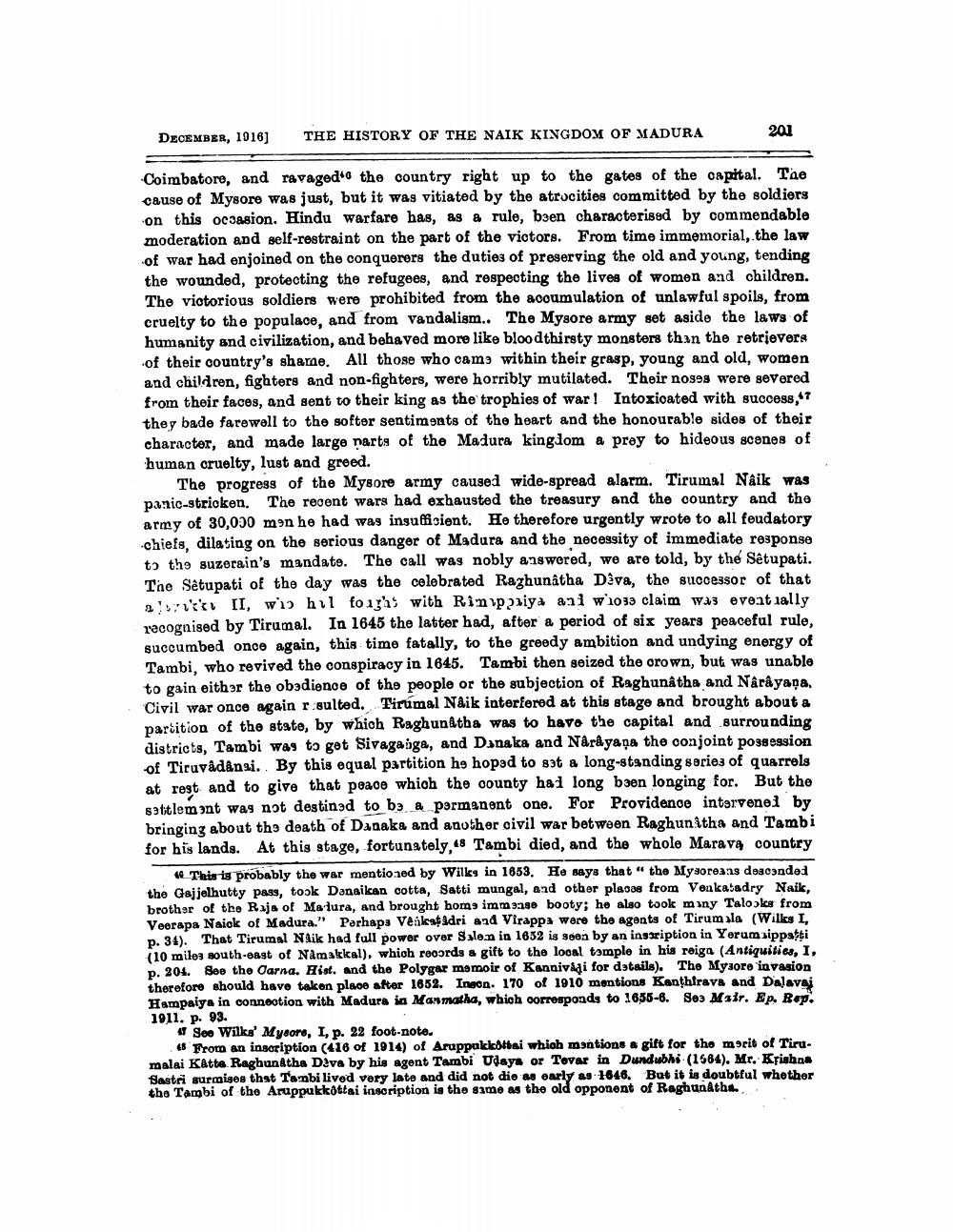________________
DECEMBER, 1916)
THE HISTORY OF THE NAIK KINGDOM OF MADURA
201
Coimbatore, and ravaged" the country right up to the gates of the capital. Tae cause of Mysore was just, but it was vitiated by the atrocities committed by the soldiers on this ocasion. Hindu warfare has, &s & rule, buen characterised by commendable moderation and self-restraint on the part of the victors. From time immemorial, the law of war had enjoined on the conquerers the duties of preserving the old and young, tending the wounded, protecting the refugees, and respecting the lives of women and children. The victorious soldiers were prohibited from the acoumulation of unlawful spoils, from cruelty to the populace, and from vandalism.. The Mysore army set aside the laws of humanity and civilization, and behaved more like bloodthirsty monsters than the retrievers of their country's share. All those who came within their grasp, young and old, women and children, fighters and non-fighters, were horribly mutilated. Their noses were severed from their faces, and sent to their king as the trophies of war! Intoxioated with success.47 they bade farewell to the softer sentiments of the heart and the honourable sides of their character, and made large narts of the Madura kingiom a prey to hideous scenes of human cruelty, lust and greed.
The progress of the Mysore army caused wide-spread alarm. Tirumal Naik was panio-strioken. The recent wars had exhausted the treasury and the country and the army of 30,000 men he had was insufficient. He therefore urgently wrote to all feudatory chiefs, dilating on the serious danger of Madura and the necessity of immediate response to the suzerain's mandate. The call was nobly answered, we are told, by the Setupati. The Satupati of the day was the celebrated Raghunatha Dāva, the successor of that
uss II, wo hil forras with Rinpriya ani w 1033 claim was eveat ially recognised by Tirumal. In 1645 the latter had, after a period of six years peaceful rule, succumbed once again, this time fatally, to the greedy ambition and undying energy of Tambi, who revived the conspiracy in 1645. Tambi then seized the crown, but was unable to gain either the ob3dience of the people or the subjection of Raghunatha and Nârâyaga. Civil war once again risulted. Tirumal Naik interfered at this stage and brought about a partition of the state, by which Raghunatha was to have the capital and surrounding districts, Tambi way to get Sivaganga, and Danaka and Narayana the conjoint possession of Tiruvádânzi.. By this equal partition he hoped to sat a long-standing series of quarrels at rest and to give that peace which the county hai long ben longing for. But the settlement was not destined to b3 a permanent one. For Providence intervenol by bringing about the death of Danaka and another civil war between Raghunitha and Tambi for his lands. At this stage, fortunately, 48 Tambi died, and the whole Maravą country
a
This is probably the war mentioned by Wilks in 1653. He says that "the Mysoreas desondes the Gajjelhutty pasy, took Danaikan ootta, Satti mungal, and other places from Venkatadry Naik, brother of the Raja of Ma-lura, and brought home immaso booty; he also took miny Talooks from Veerapa Naick of Madura." Parhaps Veiksgadri and Virappa were the agents of Tirumala (Wilks I, p. 34). That Tirumal Naik had full power over Salen in 1652 is seen by an insaription in Yorum sippstti (10 miles south-east of Namakkal), which reoords & gift to the local tomple in his reiga (Antiquities, I, P. 204. See the Oarna. Hist, and the Polygar memoir of Kannividi for details). The Mysore invasion therefore should have taken place after 1652. Ingon. 170 of 1910 mentions Kanthirava and Dalavai Hampaiya in connection with Madura in Manmatha, which corresponds to 1655-6. Se3 Msir. Ep. Bop. 1911. p. 93.
Soo Wilks' Mysore, I, p. 22 foot-note.
From an insoription (118 of 1914) of Aruppukkottai which msntions a gift for the morit of Tiru. malai Katta Raghunatha Dava by his agent Tambi Ulaya or Tovar in Dundubhi (1564). Mr. Krishna Sastri surmises that Tanbi lived very late and did not die as early as 1846. But it is doubtful whether tho Tambi of the Aruppukkottai inscription is the same as the old opponent of Raghunathi.




